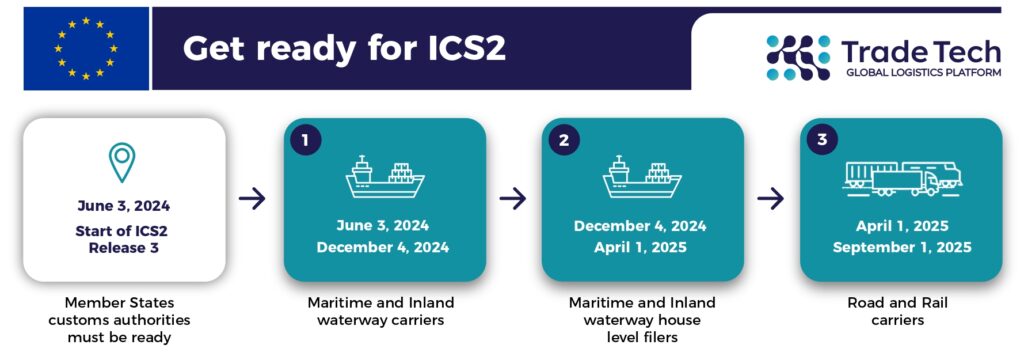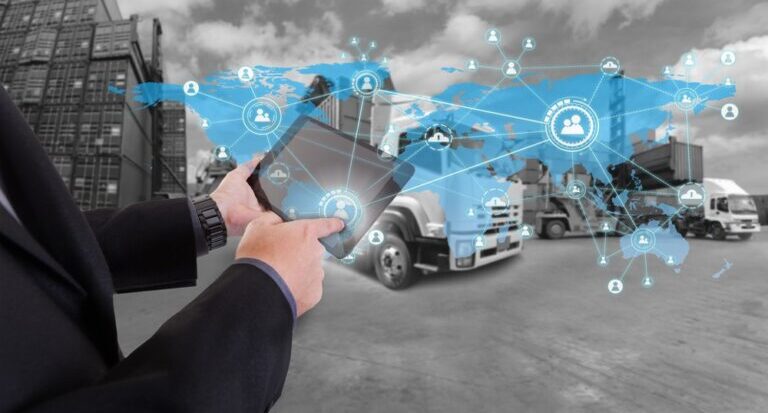The second phase of the European customs import system has been postponed, and this delay allows the industry to get prepared.
By Bryn Heimbeck, president and co-founder of Trade Tech, an industry-leading global logistics platform and provider of innovative cloud-based supply chain management software solutions.
The ecosystem of international trade is continuing to take on increased complexity. Carriers physically moving freight remains essential, but without data, shipments aren’t going anywhere fast. Data moves freight. And incorrect, untimely, or missing data disrupts the movement of goods.
It is through this lens that we need to look at Import Control System 2, or ICS2 – the second phase of electronic customs import system for the European Union. It is a large-scale advanced cargo information (ACI) system that manages the advance safety and security risk analysis of all goods entering the European Union (EU). Those involved in the truck, rail and ocean transportation sectors will need to have the technical infrastructure, processes, and procedures in place to submit ACI to customs authorities via the ICS2 system when it goes live for Vessel Operators on June 3, 2024, and for House Bill Filers on December 4, 2024 (postponed from March 1, 2024).
Need Drives Change
ICS was viewed as inadequate to keep up with the increasing volume of trade and the growing threat of terrorism and organized crime. ICS2 was created to address these problems by collecting and exchanging data on goods before they arrive in the EU. This information is used to identify high-risk consignments, target inspections, and ensure goods comply with EU regulations.

With the new system bad actors are more likely to be caught. Trusted shippers should enjoy rapid customs clearance and greater velocity in their overall supply chains. And everyone will need to step up the technology being deployed to ensure the fluid movement of cargo. Companies will need to decide if they want to continue to deal with the inefficiencies and problems associated with their legacy systems or if they want to adopt a more forward-thinking, multi-party single platform that facilitates seamless integration with ICS2, carriers, port terminals and other customs systems around the world. As the founders of one of the first global logistics platforms, we at Trade Tech would advocate for the latter.
ICS2–What’s New
ICS2 builds on the success of ICS-1 and introduces several new features, including:
- A single-entry point for submitting advance cargo information (ACI): This will make it easier for the industry to comply with the requirements of ICS2.
- A risk assessment system: This will help customs authorities to prioritize their inspections and to focus on the highest-risk shipments.
- A secure messaging system: This will allow customs authorities to communicate with the industry and exchange information more easily.
- A more flexible system: ICS2 is designed to be more flexible than ICS-1, which will make it easier to adapt to changes in the way that goods are traded.
Air express and air mail went live with ICS2 a year ago, with the balance of air cargo starting July 1. Vessel Operators plan to go live on June 3, 2024, and for House Bill Filers on December 4, 2024 (postponed from March 1, 2024). What about rail and truck? Compliance is mandatory for all goods entering the EU, regardless of their origin or destination. Non-compliance may result in fines or delays in the customs release of the cargo.
Compliance and Timing
The ICS2 filing requires a complete set of Entry Summary Declaration (ENS) data on goods moving into or out of the EU border. Information required in an ENS relates to the means of transport; the route used to enter and move through the EU; the persons or companies involved in the transaction (consignor, consignee, carrier, etc.), and details on the goods being brought into the EU, including Harmonized System (HS) Code
ENS submission deadlines vary by mode of transportation and origin. For example, the deadline for short haul flights is no later than the actual time of departure, while ocean containerized cargo is no later than 24 hours before the goods are loaded at the port of departure.
Technology and Connectivity Challenges
If all of this sounds daunting, it can be, particularly if you are working with multiple import-export systems and/or systems that lack connectivity or cannot be accessed anywhere in the world.
Connectivity is critical because ICS2 reaches out globally for all cargo bound for the EU and accessibility via a web browser is paramount. Likewise, ICS2 will involve shipments in and out of Europe so this will often mean two filings, not just one. Trans-Atlantic cargo will need to have an export ICS2 filing and an Automated Manifest System (AMS) filing; Importer Security Filing (ISF) (or Electronic Manifest), or all three. Connectivity alleviates the need to rekey this same data three different times in three different systems, thereby reducing inefficiencies and opportunities for errors.
ICS2 also introduces another global standard for global supply chain and transportation data. Looked at this way, ICS2 is another 24-Hour Rule Security Filing like AMS / ISF, E-Manifest, Mexican AMS, Japan Advance Filing Rule, and South African Risk Compliance System. All data related to a shipment is required to be transmitted to the destination customs agency 24 Hours prior to loading on board the vessel. This is the visibility Customs requires and the industry says it needs.
Finding a Solution in a Single, Globally Accessible Platform
With ICS2 the industry should be taking greater advantage of this defacto standard to enhance the movement and use of shipment data. This can happen with the use of a singular globally accessible import-export platform that interfaces with all the parties involved in the movement of cargo, including governmental regulatory agencies around the world.
Trade Tech offers a powerful global logistics platform that facilitates multi-party collaboration, which helps shippers, forwarders and other entities comply with ICS2 while streamlining the entire shipping process. Digitization optimizes processes from managing real-time data to complicated filings. It also can help determine, manage, collect, and utilize the data elements required for ICS2 compliance. And such a platform can also aid in visibility, control, and information sharing, which is particularly important for ensuring carrier filings mirror forwarder filings.
Trade Tech’s is one of the only providers with compliance solutions that encompass a multitude of global security filing types, including the Advanced Manifest System (AMS), Importer Security Filing (ISF), EU ENS (ICS2), Japan AFR, Canada eManifest, Mexico AMS and South Africa SARS, ensuring a full compliance portfolio for customers. The systems developed by Trade Tech provide direct electronic connections to many customs systems and preparation for integration for ICS2 with EU Customs, facilitating a complete set of Entry Summary Declaration data for goods moving into or out of the EU border, has been underway for some time.
ICS2 promises to be a revolutionary digital solution for the declaration and control of goods entering the EU. It is designed to offer improved data-driven customs security processes, which are paramount for protecting the EU’s internal market and citizens against potential security and safety threats. Compliance will be challenging for those not prepared. Seeking out an import-export platform solution now can help you seamlessly transition to the new ICS2 requirements.
Remember: Data – accurate, timely data – moves freight.
About the author
Bryn Heimbeck is president and co-founder of Seattle-based Trade Tech, Inc. and has been a pioneer in the Global Logistics and Supply Chain Industry for more than 25 years, championing the Cloud, Digitization, and the Internet as the most powerful new technologies available to this industry.
Heimbeck partnered with co-founder Kevin Clark in 1997 leveraging the Internet to create a global transportation management system on a single, globally accessible, multi-tenant platform which is connected to ocean and air carriers as well as Customs agencies around the world.
Trade Tech is the result of Heimbeck’s initial career in the shipping and logistics business.
This created his first hands-on experience with technology to improve the management of large volume cargo flows. His experience taught him that logistics customers need consistency and predictability in their supply chains, and that digitization and automation are powerful tools for a Forwarder to deliver on the customer’s expectations. Heimbeck has grown Trade Tech’s global presence to include nine offices around the world.
Since 1997, global logistics solutions provider Trade Tech has been developing world-class applications that link shippers, importers, Customs House Brokers, consignees, NVOCCs, carriers, truckers, warehouses, and forwarders, providing visibility of the movement of goods throughout the supply chain. The Trade Tech multi-tenant platform offers its customers a streamlined approach to elevate efficiency within their supply chains, enhancing visibility, increasing connectivity, reducing costs, and minimizing errors. Trade Tech customers enjoy access to the latest applications and data anywhere in the world every time they log on to the Trade Tech network – without any software downloads. For more information, please visit: tradetech.net. For more information on ICS2 please visit Trade Tech’s dedicated page here or view FAQs here.



